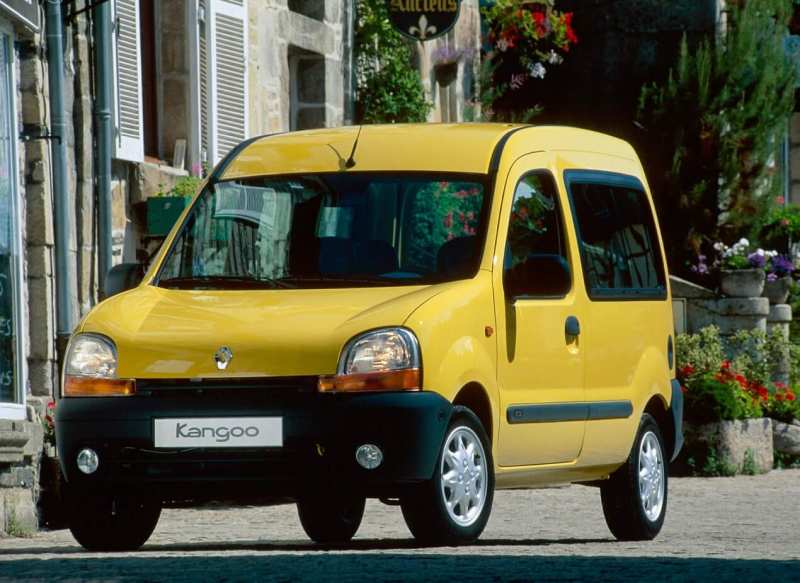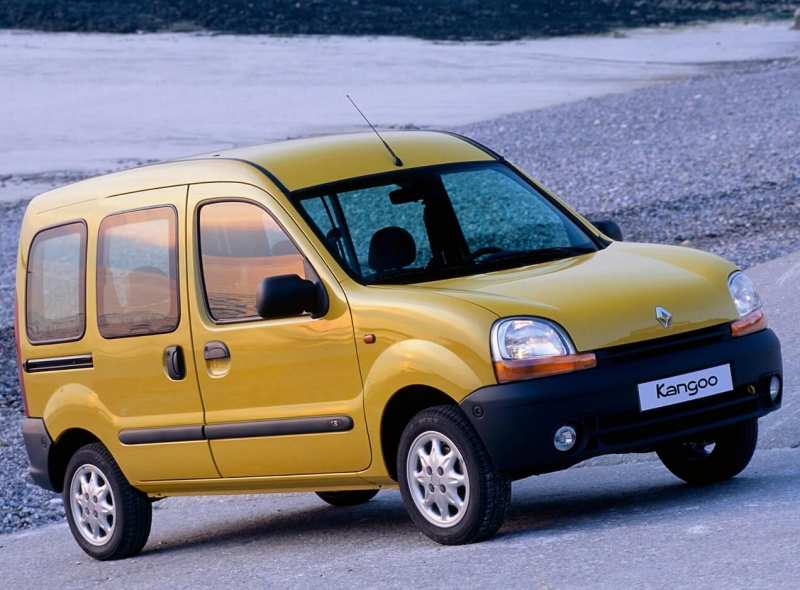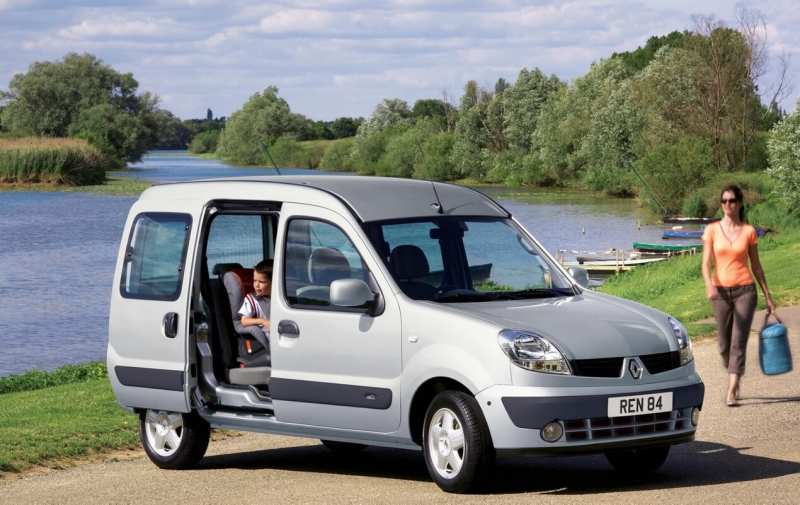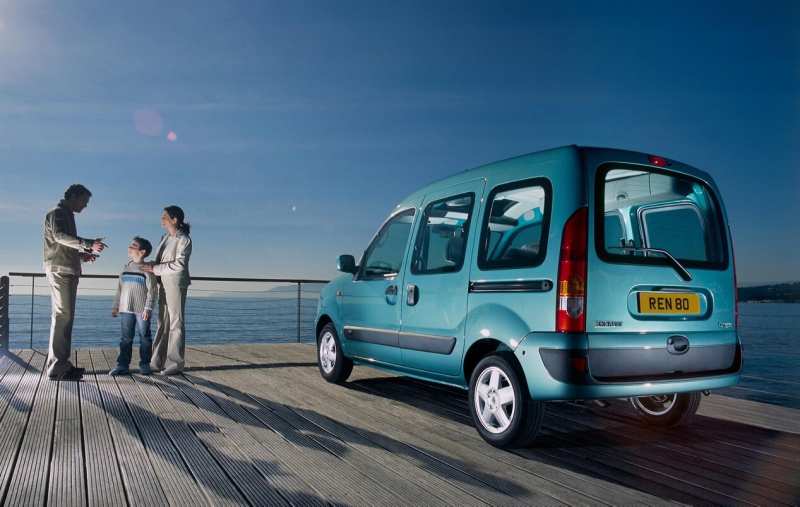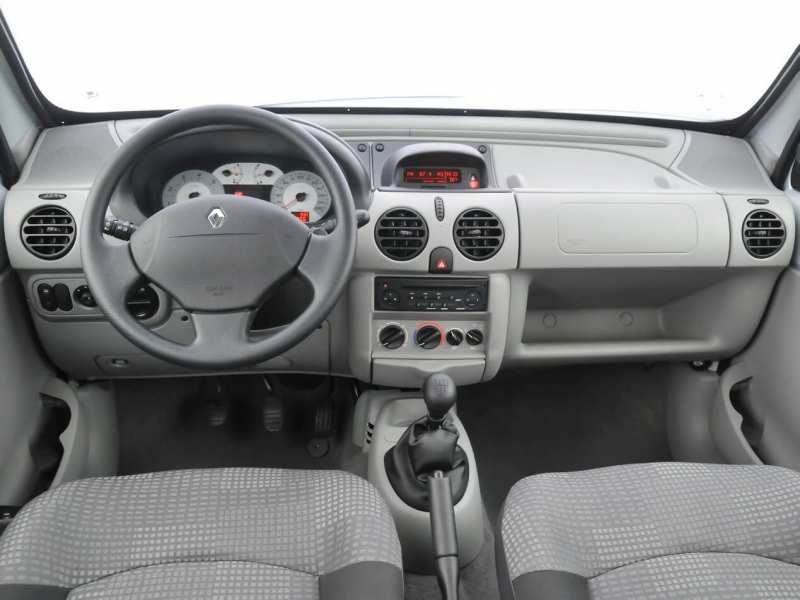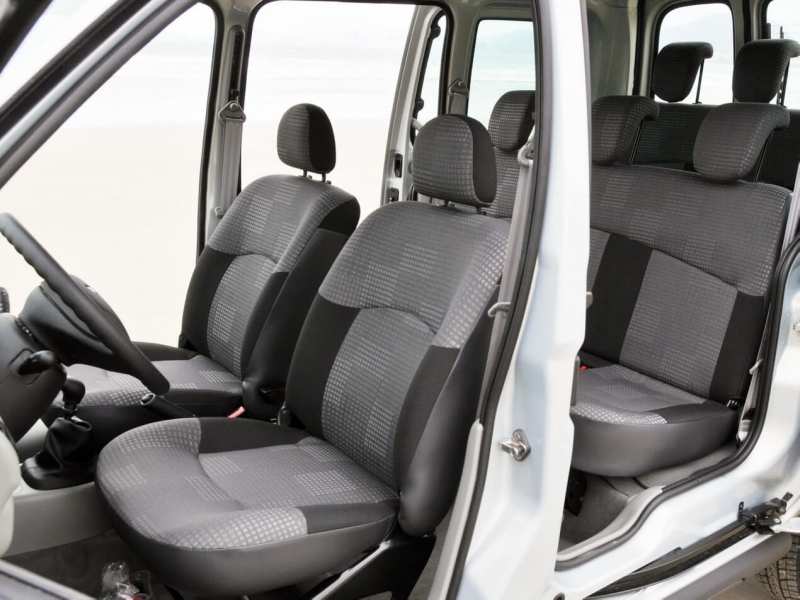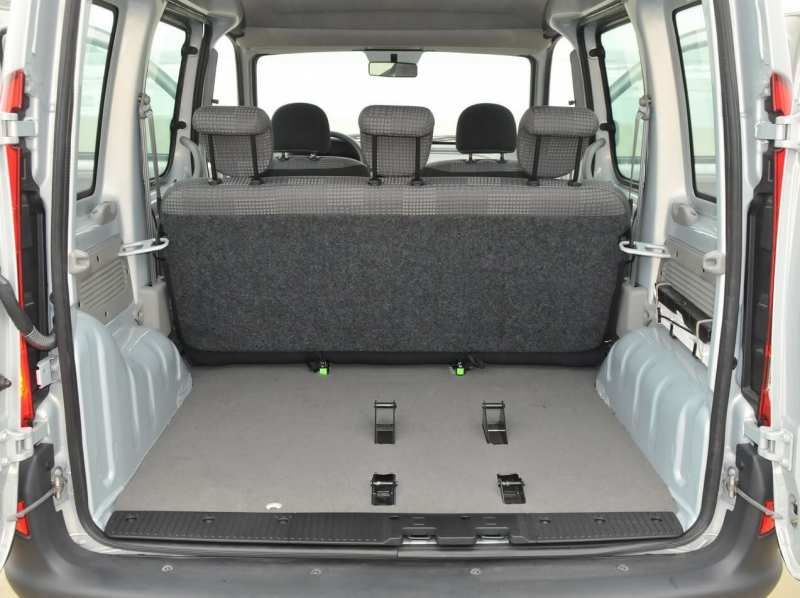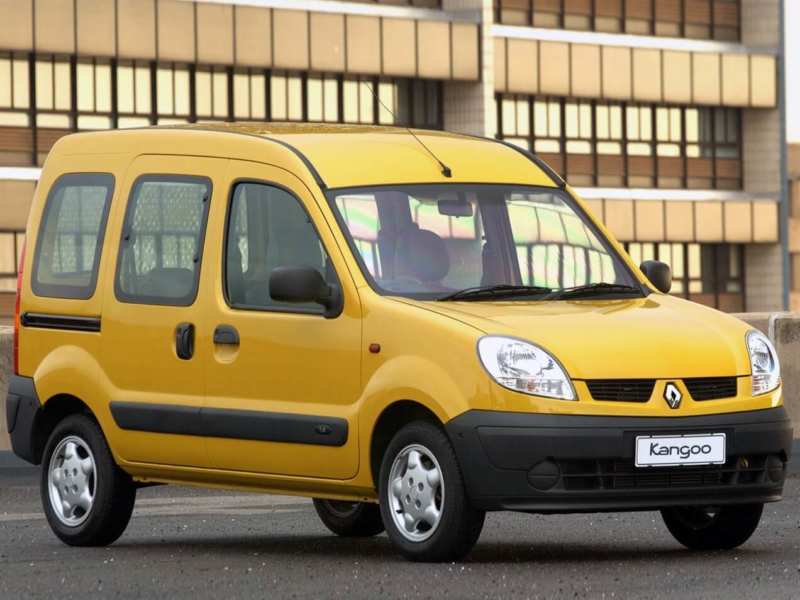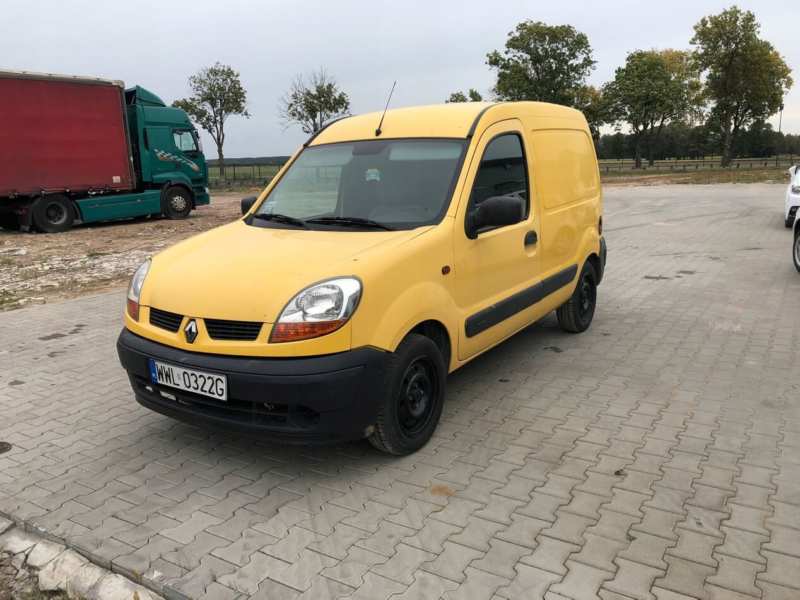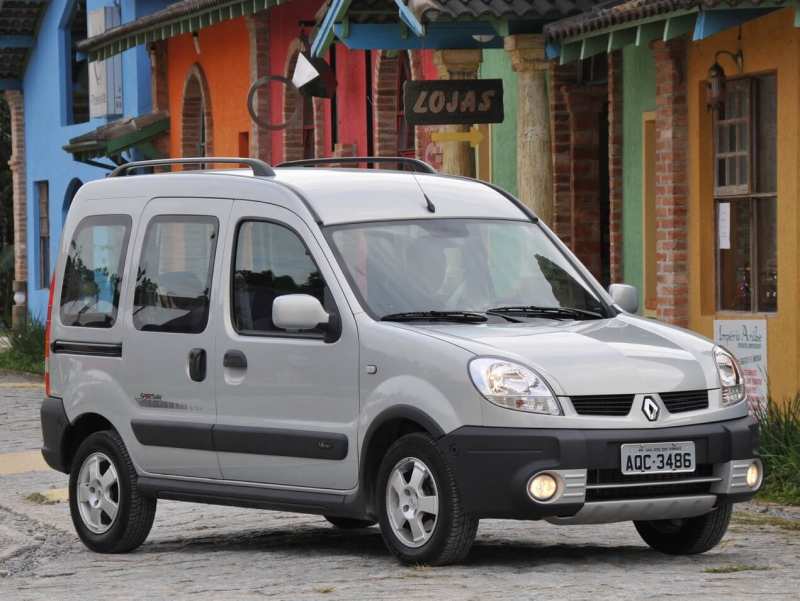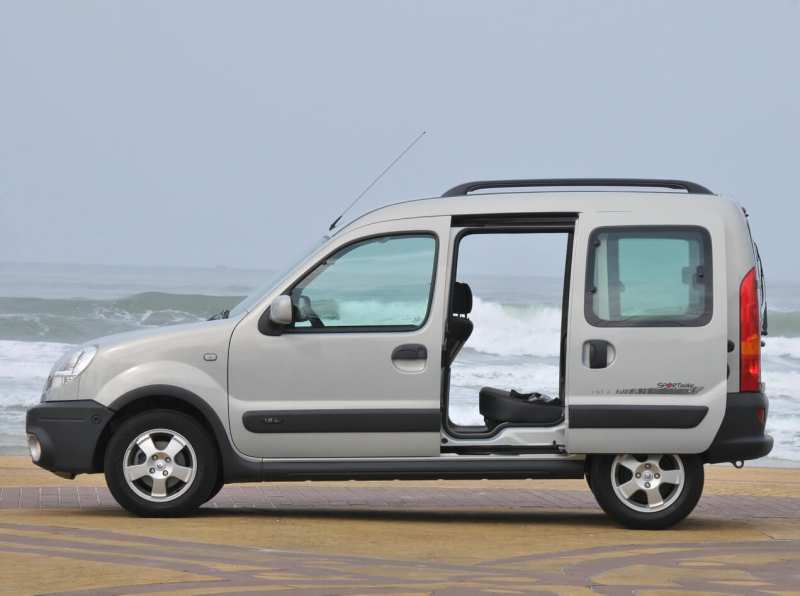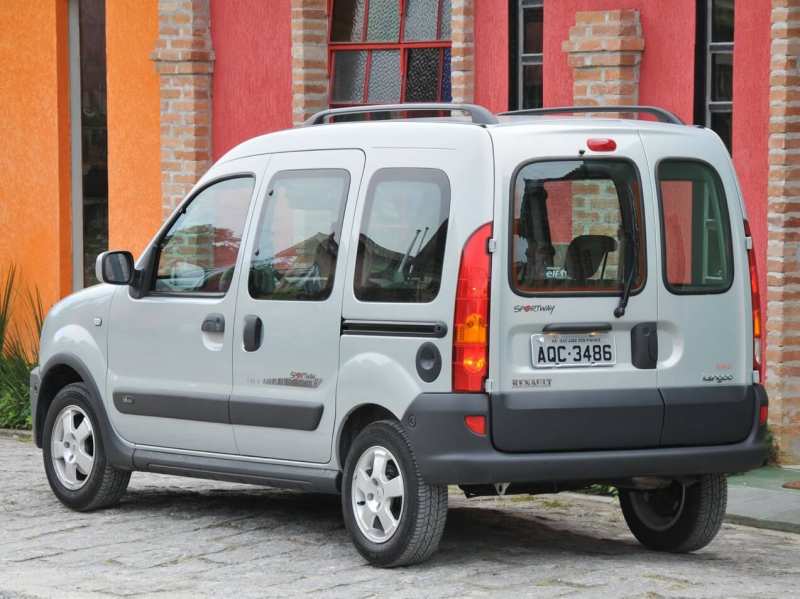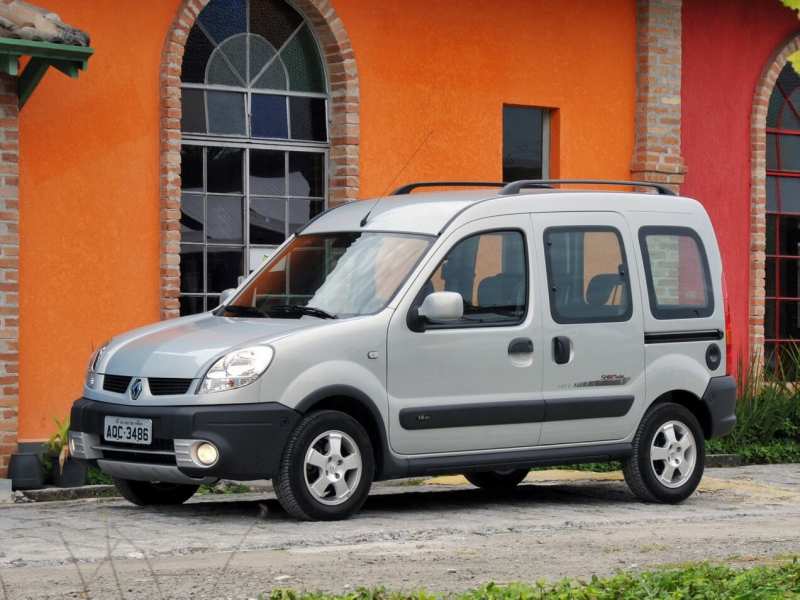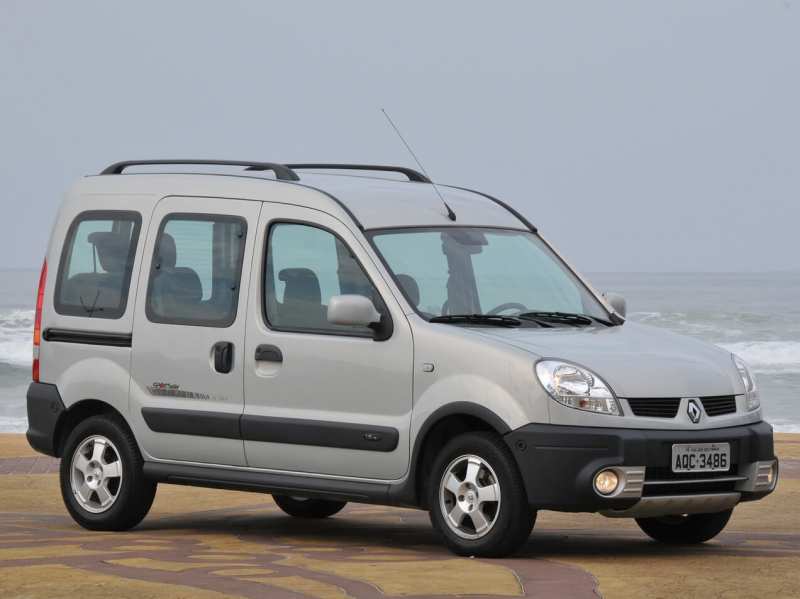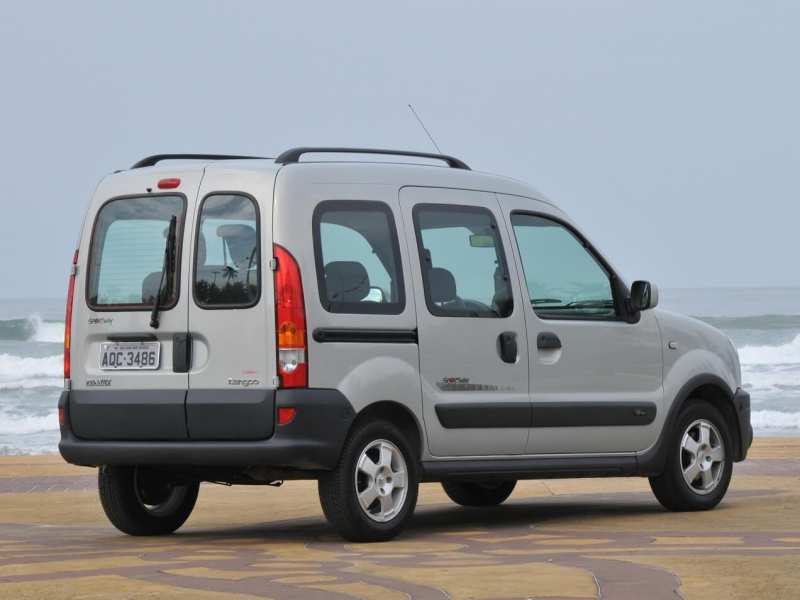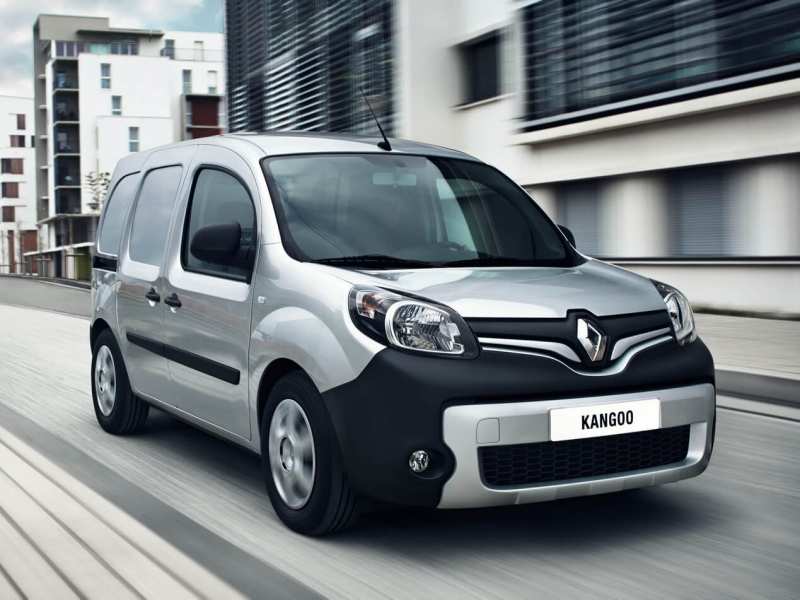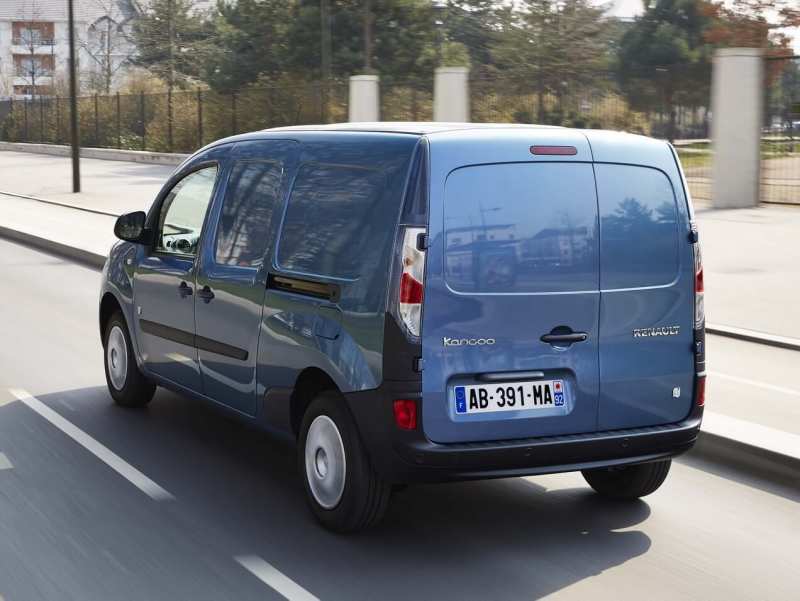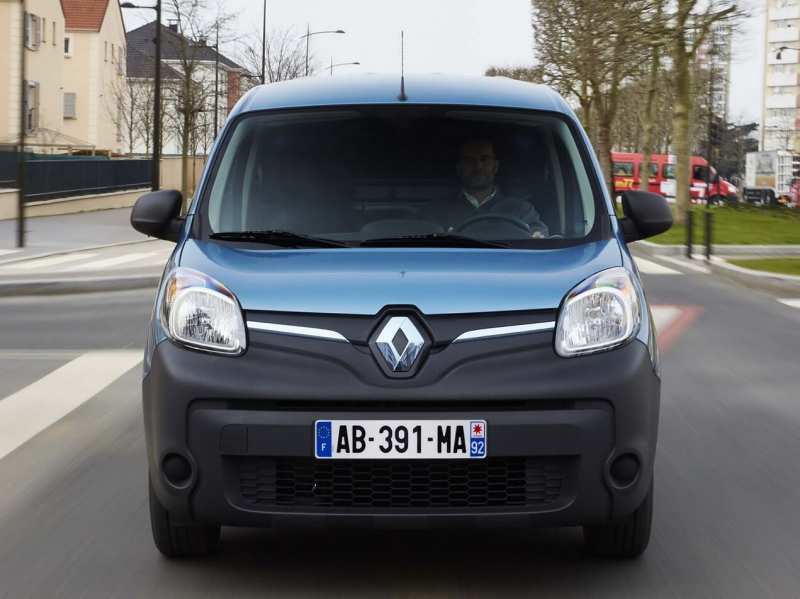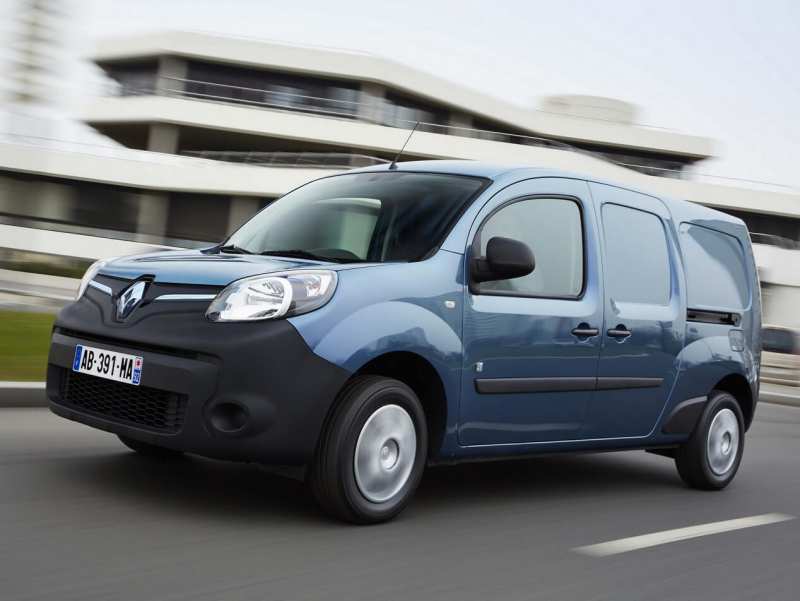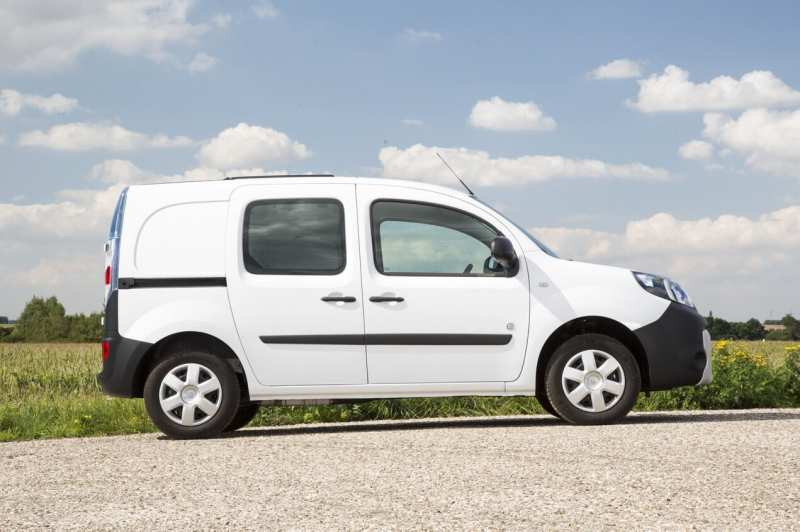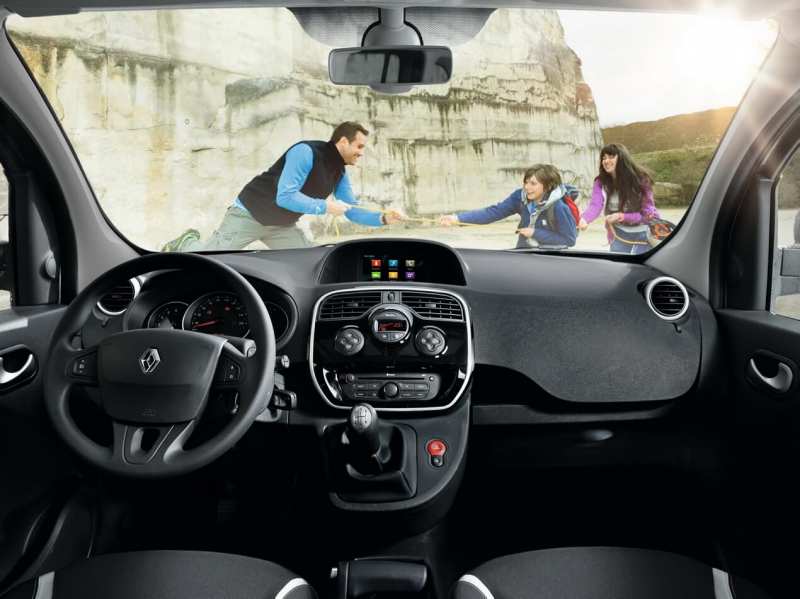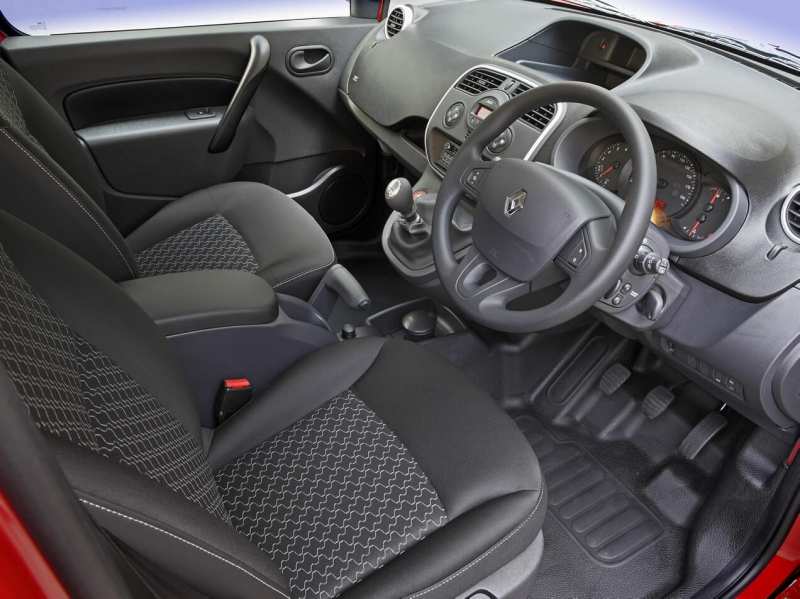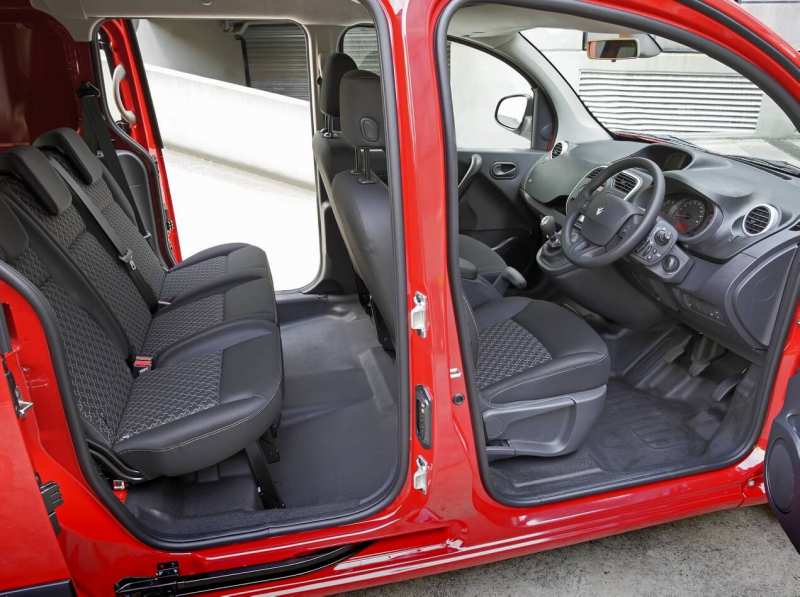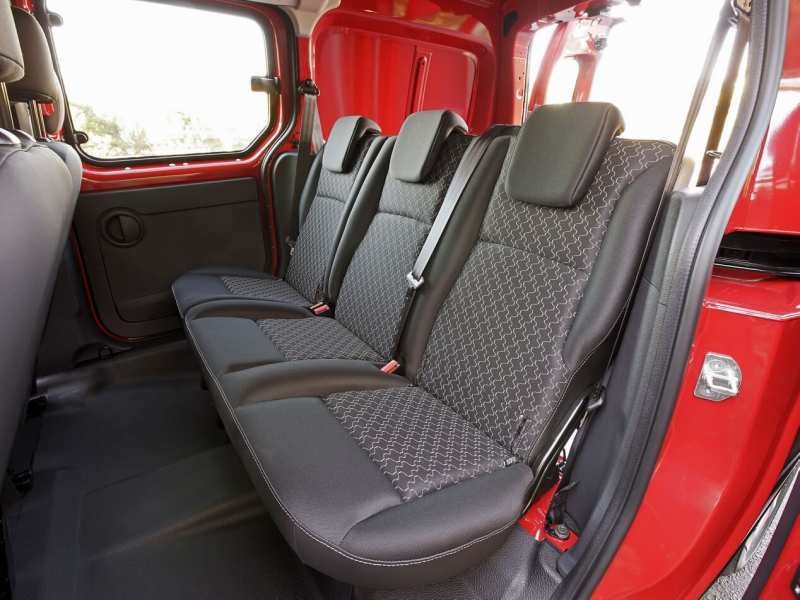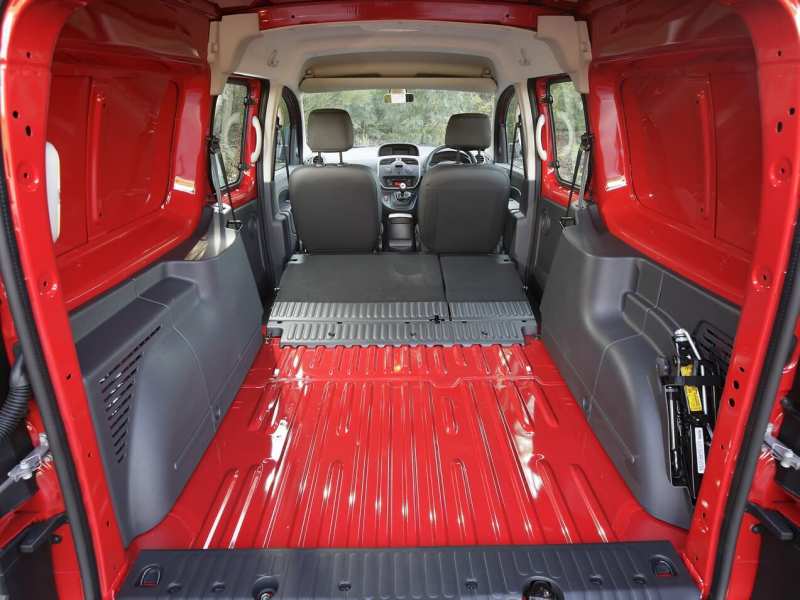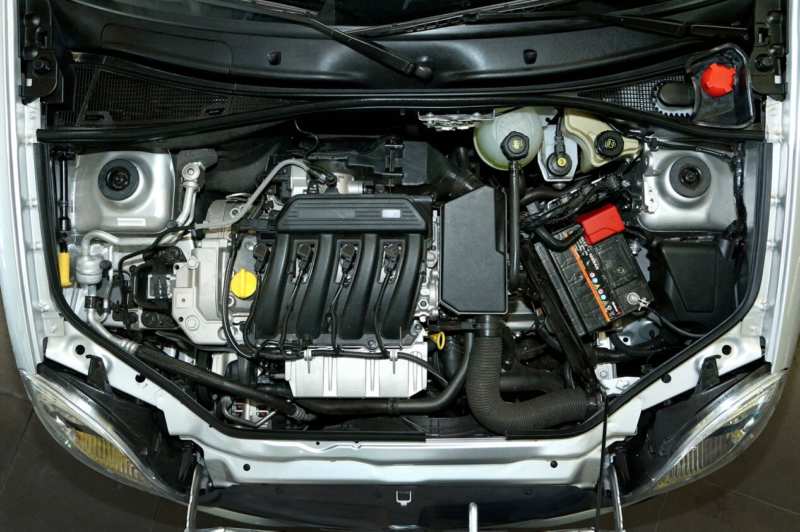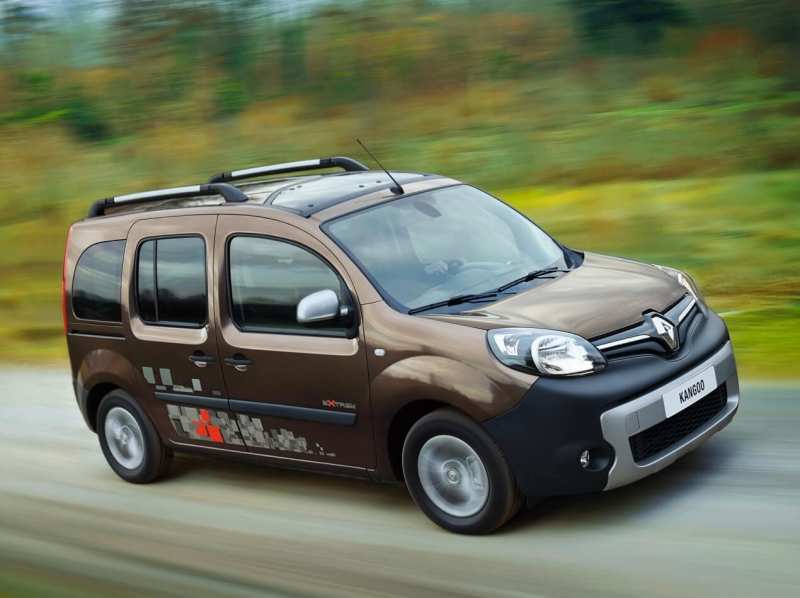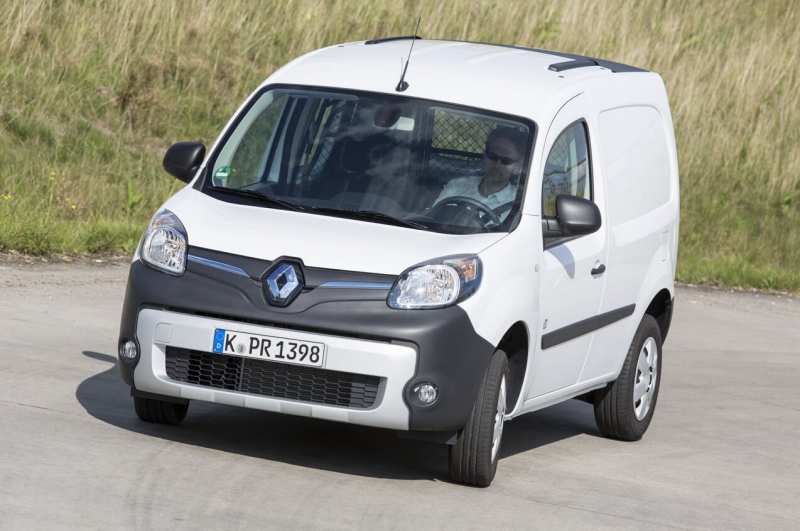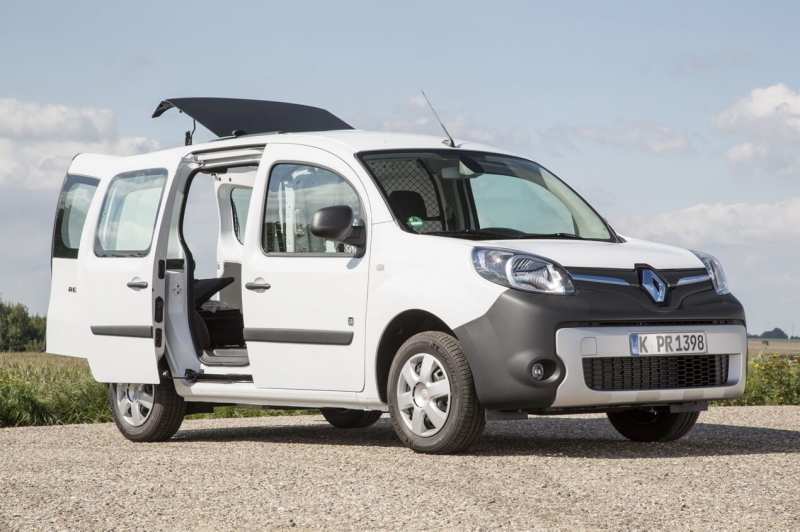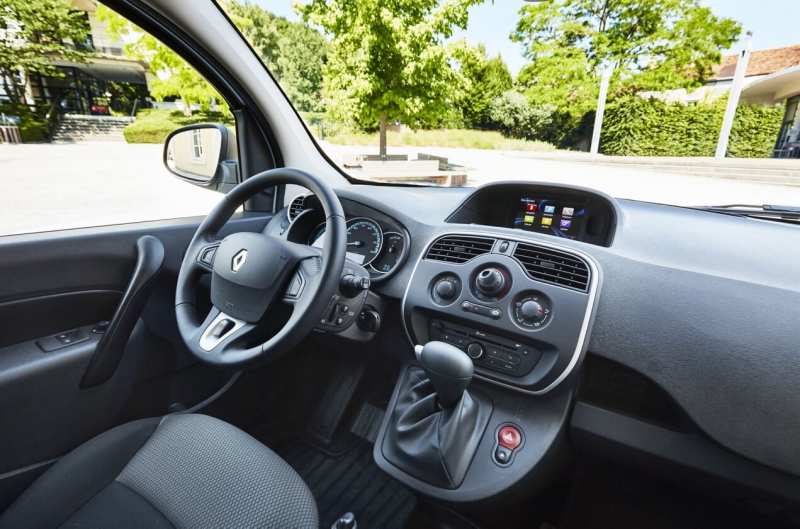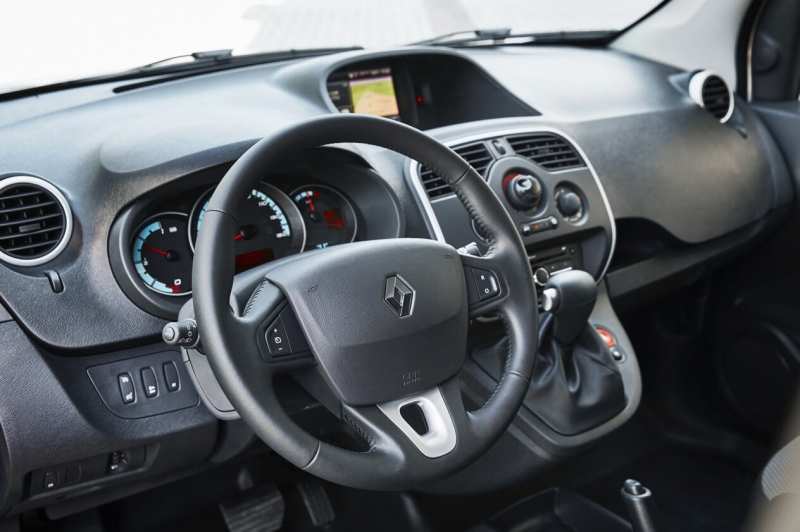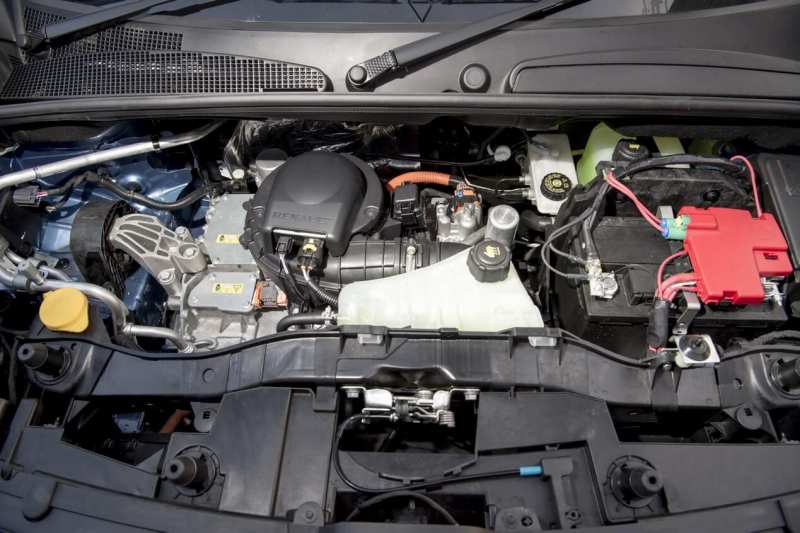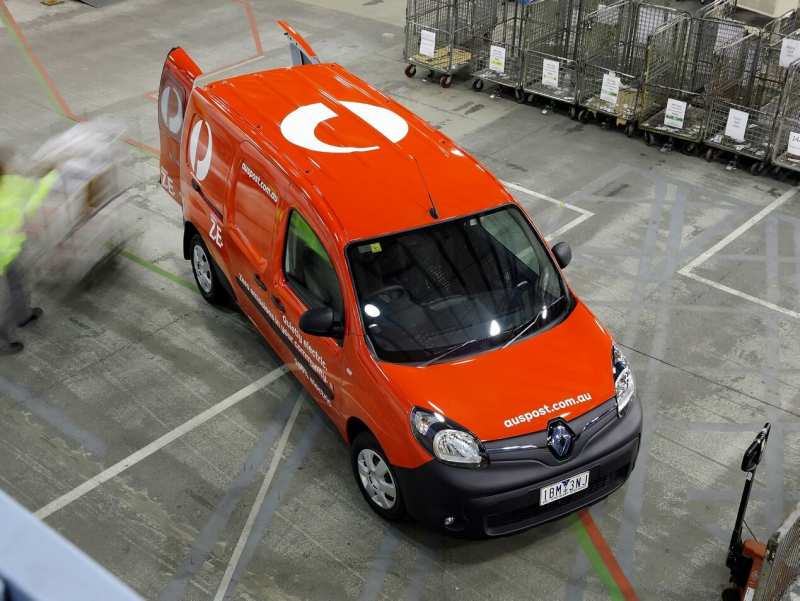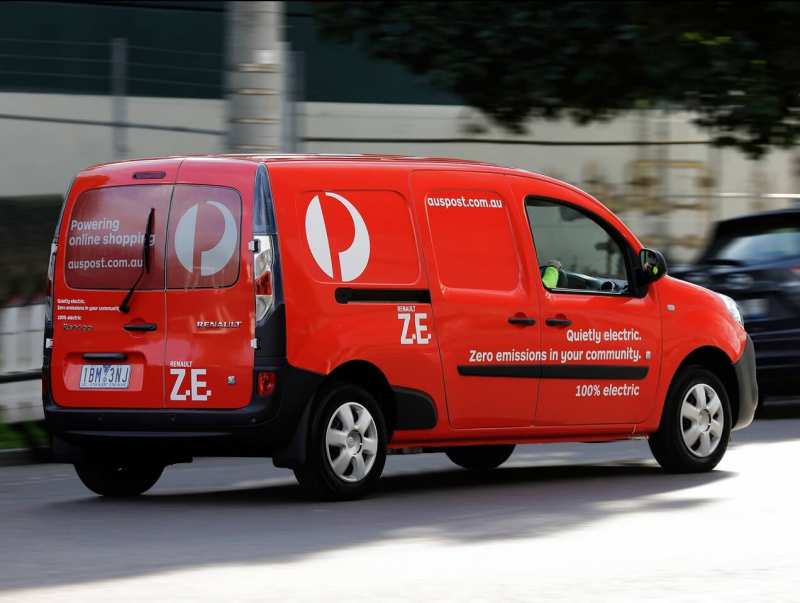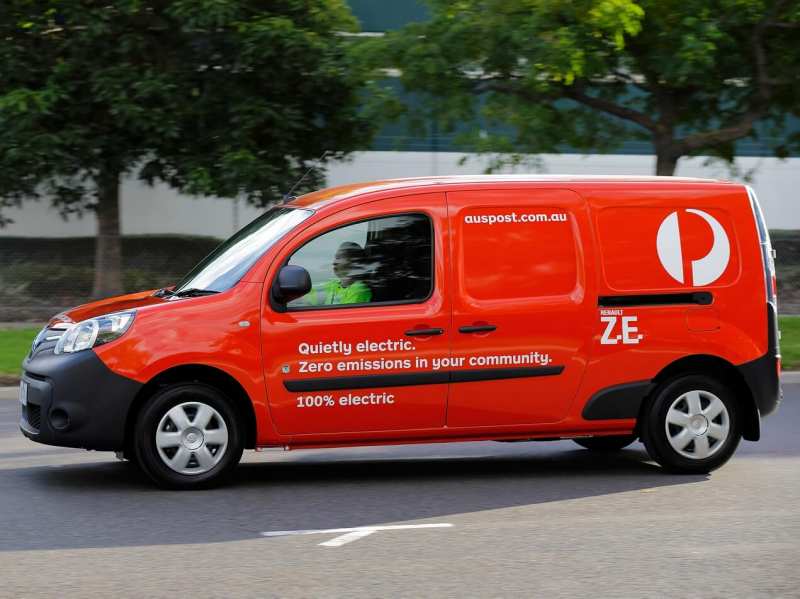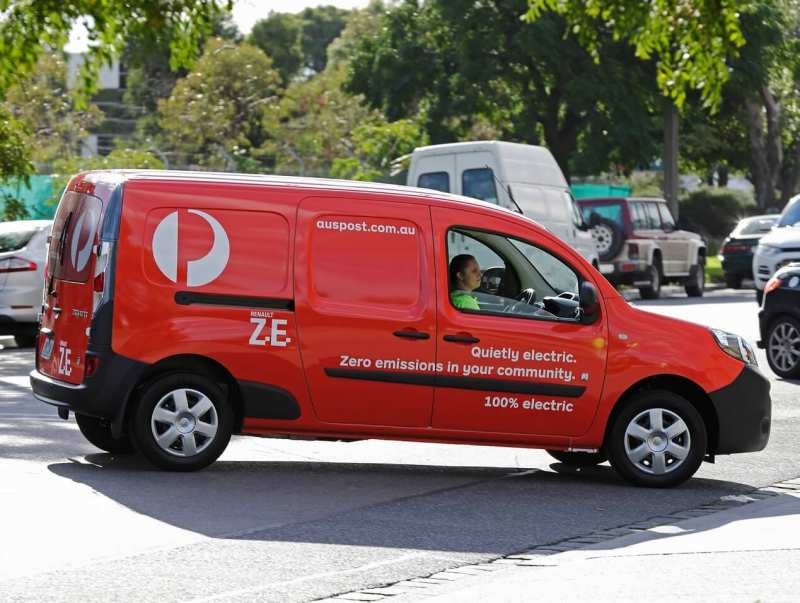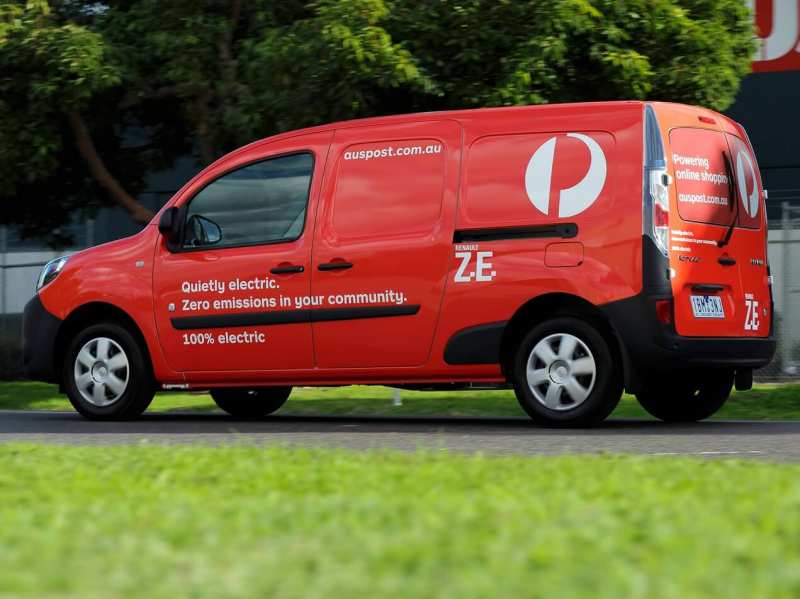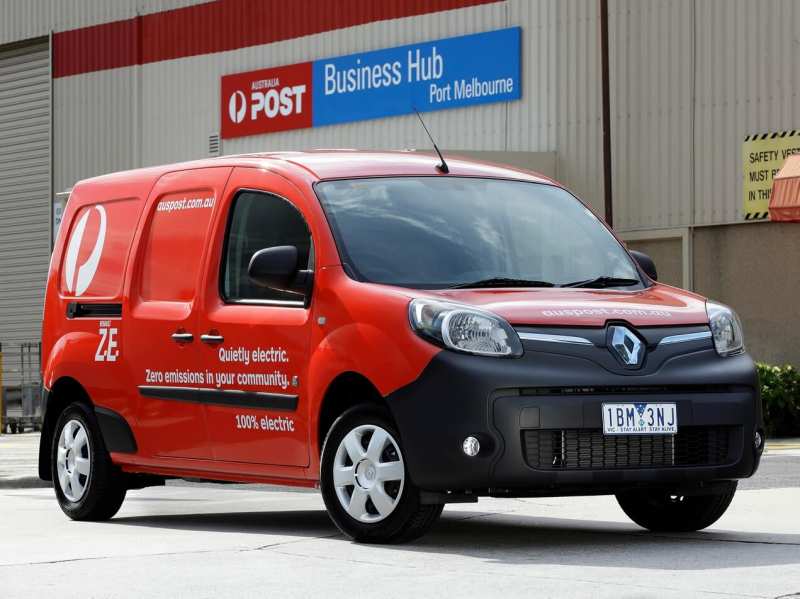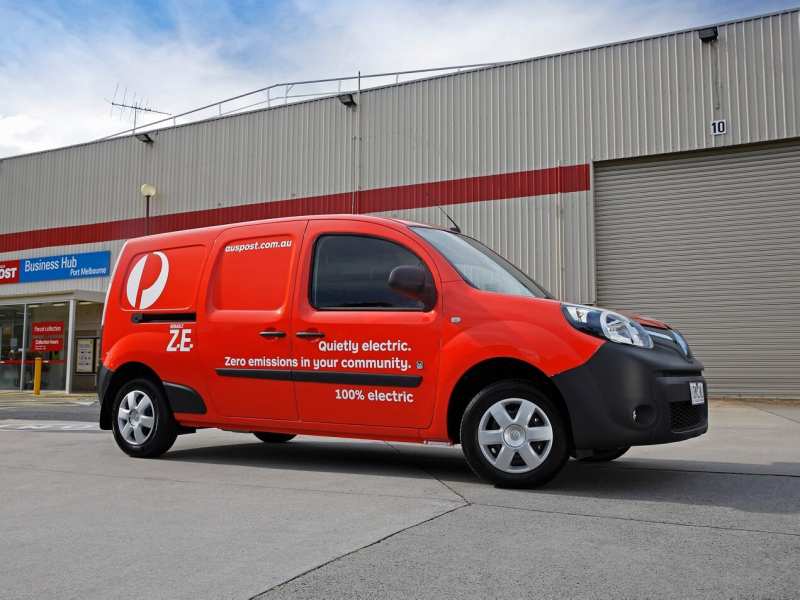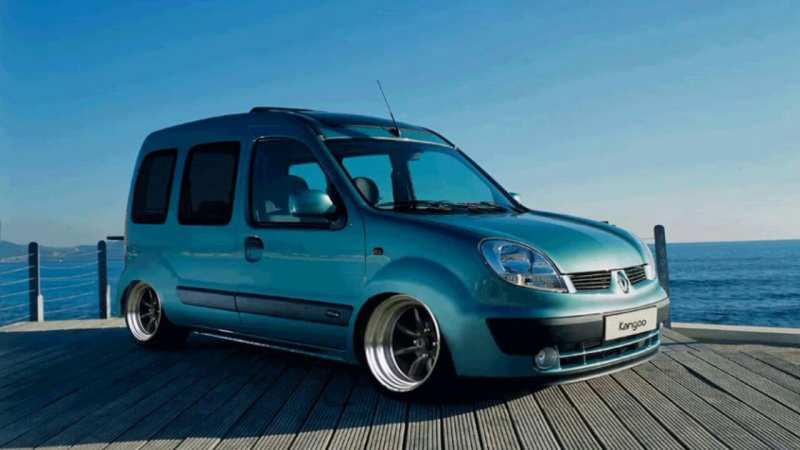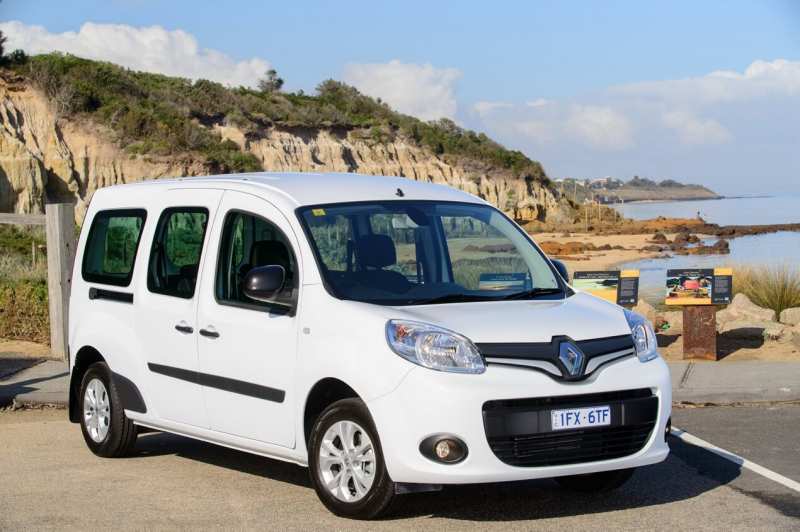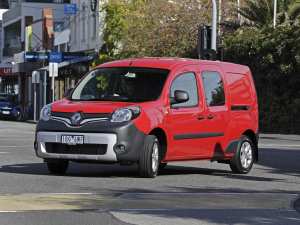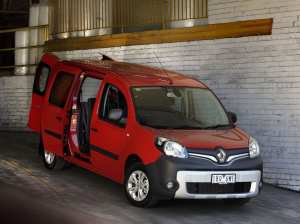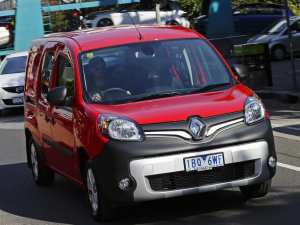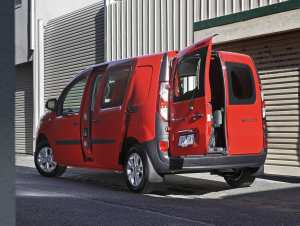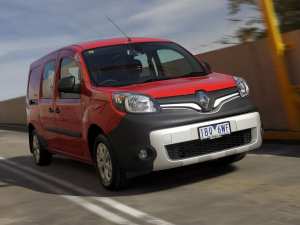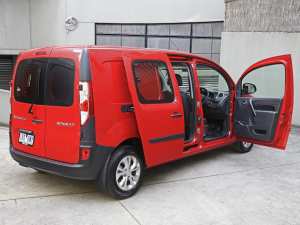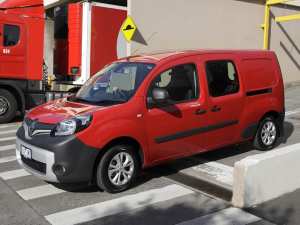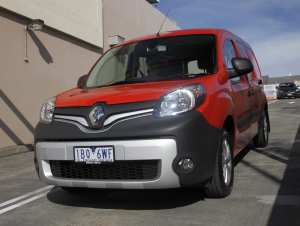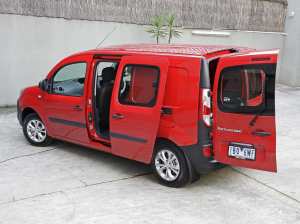Renault Kangoo
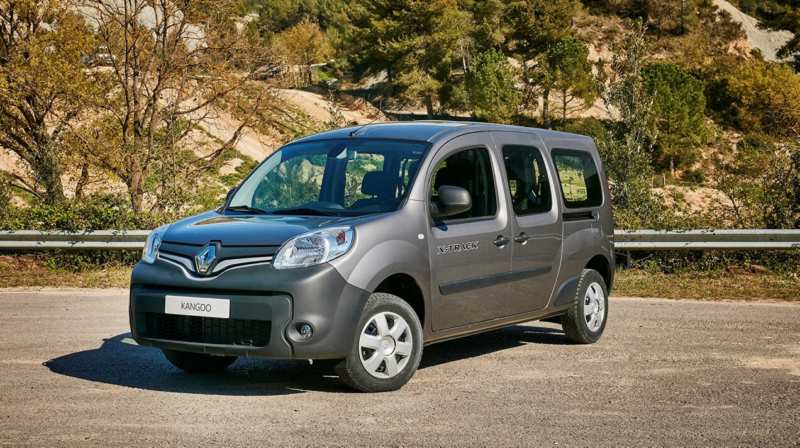
The Renault Kangoo is a front-wheel drive “multi-purpose vehicle” for passenger and freight applications. The machine is equally successful as a vehicle for a large family and also performs well as a “heel”. Renault Kangoo combines small size, spacious interior, as well as a fairly acceptable price tag. The whole model range is Renault.
- Car history
- Generation I (1997-2007)
- Technical part of Renault Kangoo I
- II generation (2008-present)
- Appearance
- Salon
- Specifications
- Powertrain
- Transmission
- Chassis
- Security
- Complete set and prices
- Electric version of Renault Kangoo Z.E.
- Exterior
- Interior
- Specifications
- Z.E. power pack
- Z.E. transmission
- Battery pack
- Z.E.’s running gear
- Complete sets and prices Z.E.
- Tuning
- Comparison with competitors
- Reviews from the owners
- The pros and cons
- Tooths
- Renault Kangoo photo
Car history
This car replaces the Express car. It joined the model list of the French brand in 1997. The car debuted in autumn during the international Frankfurt Motor Show. “The Frenchman quickly became popular in the commercial market of many countries. The last update of the French “worker” received in 2013.
In addition, the French company also decided to release in 2011 an electric version of the car, which received the prefix “Z.E.”. Nowadays, this “heel” is in good demand all over the world – every year it is bought in thousands of copies.
Generation I (1997-2007)
The history of the Renault Kangoo brand started in 1997. During the Geneva exhibition, the car company from France presented a futuristic concept-version of Pangea. A year later the serial version of the car was released. The car did not differ from the prototype in terms of design. But in terms of design they were different. The shape of the new car body resembled a typical “heel”.
For the whole “life” this car has changed 2 generations and dispersed around the world in the circulation of more than 3 000 000 copies.
From the beginning, the car was offered with only one sliding rear door. In 1998, modifications with sliding doors on both sides began to be produced. This solution was unique to Renault Kangoo 1. In terms of popularity, the new product was able to outpace even minibuses and minivans in a number of European countries.
After 2001, French specialists were able to update Renault Kangoo 1 a little bit. The upgrade was mostly related to facelift. Besides, the product line has been replenished with all-wheel drive version Trekka (Pampa). In those days, only some “classmates” had a similar option at their disposal.
Off-road Renault Kangoo 4×4 had black plastic overlays, tinted headlights, increased clearance. Renault Kangoo’s 1st generation exterior was also changed. Processing affected the hood, front bumper, grille and headlights. The plastic for the car was chosen to be of a higher quality, and the quality of the noise insulation was significantly improved.
With the help of an upgrade, which has been made after 2 years, the car looked even better, and also received an increased list of available power units. The car was produced until 2007, although in the Celestial Empire and Argentina, the “Frenchman” stands on the conveyor assembly to this day. Russian consumers could buy Renault Kangoo of I generation till 2010.
After 2003, the car was equipped with large headlamps, which received a droplet shape, as well as rear lights in a new design. In addition, the car had new bumpers to match the color of the body, where you can find black shockproof pads. The radiator grille was divided into 2 parts, between which a nameplate was installed.
Renault Kangoo has been designed for the most convenient boarding/disembarkation of passengers, as well as for cargo transportation and accommodation. The first generation of the Renault Kangaroo has a low ground clearance of only 140 millimetres. The “hiking” weight ranges from 1,055 to 1,375 kilograms. The minivan version is equipped with one or two (whichever version) sliding doors, a large luggage compartment, a spacious transformative cabin with a rear seat, which is divided into 3 parts.
The Renault Kangoo I of the family was also known under the name of Nissan Kubistar, and the “heel” of the 2nd generation received a “twin brother” in the person of Mercedes-Benz Citan.
Inside the French car there are many compartments for trifling, where you can take massive shelves above the roof. The luggage compartment of the Renault Kangoo I is equipped with floor rings, safety netting and a luggage compartment that helps to hide the contents from the eyes of outsiders. Renault Kangoo’s basic equipment includes a central locking system with remote control, front power windows and hydraulic power steering.
If you pay extra, the car already had cast wheels, rails and fog lights, audio system, air conditioning, and other “lotions”. Luggage compartment has got the volume of 650 liters of useful space. However, if desired, this volume can grow up to serious 2 600 liters.
Technical part of Renault Kangoo I
A large list of engines was available for Renault Kangoo in the first series. The machine had in-line gasoline four-cylinder engines with a working volume of 1.1-1.6 liters. Such engines received 8- or 16-valve structure of gas distribution mechanism, as well as the technology of multipoint supply.
All this made it possible to develop such “engines” 58-100 horsepower (93-148 Nm of ultimate traction). There were also diesel engines – 4-cylinder atmospheric, as well as turbine engines, which received a working volume of 1.5-1.9 liters. Such engines produced 65-80 horsepower (121-185 Nm of torque).
A five-speed manual gearbox or 4-speed automatic transmission served as the link between the engine and the wheels. By default, the French model had a front-wheel drive transmission, and the more powerful versions (100 hp gasoline and 80 hp diesel) were equipped with an automatically connected all-wheel drive with a viscoffer.
Interestingly, the original version of Kangoo is the winner of the prestigious award “Car of the Year in Russia, which the car received in 2006.
If we look at the technical part of the Renault Kangoo, the first family was based on a “bogie” with front drive, where there was an independent suspension of the McPherson type at the front and a semi-independent, torsionally working transverse beam at the back. The “Frenchman” has a rack and pinion steering system, which is equipped with a hydraulic power steering.
The heel brake system is represented by ventilated disc brakes at the front. The rear part works on the drums. All modifications are equipped with electric system ABS. Renault Kangoo has a sufficient level of safety. The body is equipped with a programmed deformation zone, which ensures the integrity of the cabin during the collision.
In addition to the electrical system ABS, the French car has a system of distribution of braking forces (EBD). Renault also boasts a driver’s seatbelt, as well as passenger airbags, seat belts equipped with pretensioners and force limiters. At a premium, side airbags were also fitted.
Renault Kangoo 1st generation is an excellent multipurpose vehicle. These models are very attractive to price tags in the market of used cars. The engines have a classic design, rather tractive, economical. However, despite the tremendous popularity, Renault Kangoo 1 has received some shortcomings. For example, the debut models are located to corrosion.
The rear door locks and sliding mechanism were often damaged (service life usually did not exceed 2 years). Over time, the cooling system has lost its integrity. The gearbox had an excessively soft mount, which was reflected in the long stroke of the transmission handle during gas expansion.
The bushings, stabilizer stands and ball bearings of the levers were damaged in a relatively short period of time. Breakdowns in the wiring often occurred, and inside the machine plastic quickly began to squeak. In addition to insufficient noise isolation, we can highlight the rigid suspension, as well as expensive maintenance.
II generation (2008-present)
“Second-generation heel was released in 2007. In 2013, the car was slightly upgraded. The car is offered in 2 body solutions and has an original appearance, simple and functional interior, as well as utilitarian equipment. This vehicle was produced in 4 versions: Compact, Van, Van Maxi and Van Maxi Crew Van, which differed from each other in capacity (500-800 kg).
In 2013, the car received an update, which affected the front end. In addition, it was possible to adjust the interior and expand the list of available equipment. The novelty was presented during the International Salon Comtrans, which takes place in Moscow on September 10-14, 2013. The European premiere of the French minivan Kangoo, which underwent facelift, was seen by everyone in early February 2013.
Appearance
During the upgrade, the French car was able to save the usual proportions and sizes. The brightest changes affected the front of the vehicle. The design group decided to endow the restyled Renault Kangoo II with new elements.
This can include small headlights that resemble almond nuts, a large front bumper with a massive “smile” of the lower air intake, as well as a huge crossbar for the installation of a number plate, made of plastic.
Especially the huge diamond of the French company Renault, installed on the stylish insert of the grille of the false radiator, which is crowned with rays of chromium, attracts the eye. Thanks to the plastic improvements made over Renault Kangoo 2, now the “heel” fully complies with the corporate standards of the French brand appearance. Otherwise, the Kangoo 2nd family body, which has been produced since 2008, decided not to change.
Yes, and whether it is necessary to radically change the appearance of the car, which is sold annually in circulation of more than 100,000 copies (Renault Kangoo is the absolute leader of the division of compact minivans in Europe). This “heel” has never been and will never be sporting, bright and aggressive. Its advantage is in another.
It is equipped with a massive and comfortable interior, which allows with a substantial reserve in all directions to sit 5 people. In addition, there is a huge luggage compartment, which will be discussed later.
In 2008, the Euro NCAP Renault Kango II won 4 out of 5 stars based on the test results.
The Renault Kangoo 2 side section attracts with its embossed wheel arches with small, attractive wheel rims. The wheels themselves can be made of steel or light alloy and have a 15-inch diagonal. The “Frenchman” is decorated with a spectacular rounded line of side glazing. Instead of past rounded lines, you can notice more “muscular” lines. The car is quite tall, so it is convenient to get in and out of it.
The side doors have a plastic lining on the front and back. Windows are wide, visibility is good. The updated Renault Kangoo 2 generation has received an average height of 148 millimeters of ground clearance. The exterior is complemented by stylish and practical rails. The rear part turned out to be spectacular and memorable. The fifth door is large, wide and has solid glass.
The “basic” version has a door that rises upwards, and if you pay extra, you can install swing “doors” that open 180 degrees. The upper part of the door received a repeater of the stop signal. Large, pleasantly shaped lanterns are placed vertically on the sides. The rear bumper is not as big as in front, but still stands out in a modest and practical form. On its side edges you can see the rear fog lights.
Salon
Sowing in Renault Kangoo 2, you realize that the car is useful, practical and comfortable. Inside there is a lot of free space. Finishing materials are not bad. The driver will be pleased with many stylish little things and accessories. The view from the driver’s seat is good – the stands do not cover a lot of space. External side mirrors are large, so they are all well visible.
Landing can be easily adjusted to suit you – there are plenty of settings. The chairs are soft, which helps you to stay on top of the road. Transmission handle is installed on the tide of cockpit and it is quite convenient to reach it. The “inhabited compartment” of the car is not rich on any design exquisite or special decisions. Inside there is a nice design and convenient ergonomics.
The salon is large and light because of the large area of lightening. If you order a panoramic roof and rush on a trip to the night stop, you can admire the stars in the sky. The salon has a laconic and well readable “toolkit”, three-spoke multifunction steering wheel, a pleasant central console, which has a color 7-inch display of multimedia system, which supports touch control (R-Link).
This system has a navigation system, telephony function and can be connected to portable music players. Basic equipment has a more archaic multimedia box. There are also thought-out “consoles” of the music system and climate control system. The minivan has a standard audio system, which can be used to listen to the radio, connect the phone via Bluetooth.
In addition, USB and AUX sockets are provided. The inside of the Renault Kangoo is simple but tasteful. The front seats have an excessively soft filler, an almost flat profile and a sufficient range of settings. The rear seats provide plenty of free space. As there is no transmission tunnel, 3 adults can be seated comfortably. The luggage compartment is huge.
Sliding side doors make it easier to get in and out of the car. Any driver will be delighted by the huge possibilities for the transformation of the trunk, as well as the flat floor formed during the folding of the 2nd row of seats. There are mounting rings, concealed and spacious shelves and niches. If necessary, the trunk can be covered with a shelf so that no one else can see its contents.
In addition, the luggage carrier of Renault Kangoo 2013 is equipped with a safety net, which allows to securely fix the transported items and hold them without moving. The luggage compartment itself has a capacity of 660 litres, but can be enlarged if the rear seats are folded down if necessary, providing an impressive 2,600 litres of storage space.
There is a full-size spare wheel hanging outdoors under the bottom. The payload of the car, which runs on diesel fuel is 633 kilograms. Based on the feedback from Renault Kangoo owners, the car is capable of carrying about 1,000 kilograms for short distances.
Specifications
Powertrain
Russian buyers can expect that the second generation of Renault Kangoo 2013 will have 2 motors. The basic version of the car received a gasoline atmospheric four-cylinder 1.6-liter power plant, which received a vertical layout, distributed fuel injection and 16-valve gas distribution mechanism. All this allows the engine to develop 102 “horses” and 145 Nm of ultimate traction.
It will take 13 seconds to accelerate from zero to 100 kilometers per hour. The maximum speed does not exceed 170 kilometers per hour. Average consumption in mixed mode is about 7.9 liters for every 100 kilometers.
In addition, an alternative 1.5-liter diesel engine with 4 cylinders, 8-valve gas distribution mechanism such as DOHC, turbocharger and Common Rail injection system were provided. This diesel engine produces about 86 horsepower and 200 Nm of torque.
The maximum speed does not exceed 158 kilometers per hour, and to accelerate to the first hundred it will take about 16 seconds. The 1.5-liter Renault Kangoo diesel engine consumes no more than 5.3 liters of diesel fuel in a combined cycle.
Transmission
Transmits the entire torque to the wheels from the engine to the five-speed manual gearbox. In the “base” only the front wheels are forced to move the “heel”, but a four-wheel drive system can also be fitted as an option.
Chassis
Looking more closely at the technical characteristics of the Renault Kangoo, it is clear that it is based on the Renault-Nissan alliance’s front-drive platform, which is called the “C”. The front area of the machine has an independent suspension with McPherson columns, transverse stabilizers and screw springs. The rear suspension was built using semi-independent architecture with a twist beam.
The vehicle is driven by a rack and pinion steering system that works with the power steering. Renault Kangoo’s braking system is represented by ventilated 280-millimeter discs in front and 274-millimeter “pancakes” in the back. “The brakes work together with electronic “lotions”.
Security
Ease of operation and safety is one of the most important criteria for both family and transport vehicles. Judging by the test drive, the French “heel” has demonstrated that with the help of improved brakes and reinforced suspension, it is possible to fit into even the steepest and most difficult corners. At the same time, good stability is ensured.
Based on the test drive, it is clear that the enlarged rear-view mirrors as well as the high ground clearance provide an ideal view for the driver. Renault Kangoo is one of the leaders in the field of safety. It is equipped with 3-point seat belts as well as two front airbags. During an accident, excessive pressure on the chest and head is prevented by a certain system.
In its niche, Renault Kangoo is considered the leader in passenger protection during impacts. The vehicle is designed to minimize the impact of a collision. The design, which has a programmable deformation, ensures the integrity of the passenger compartment during the collision. The protection system in the Renault Kangoo 2018 is capable of simultaneously activating cushions and belts equipped with force limiters and pretensioners in thousands of seconds.
Excessive pressure on the chest and head is not allowed. Emergency braking technology works in conjunction with the latest generation of ABS. This system also has an electronic braking force regulator. There is also an auxiliary braking system (BAS), ISOFIX child seat attachment and Electronic Stability Control (ESP). Still French “heel” is equipped with antispin system.
Complete set and prices
The updated version of Renault Kangoo 2016 is available in two versions: Authetique and Expression. Additional option packages are also available: Electro, Comfort and Climate. The Authetique package is the cheapest and comes with a 102 hp gasoline engine and 86 hp diesel engine. The price list starts at $ 14280, such a set of “Frenchman” is equipped:
- Moldings and 15-inch steel rollers;
- Fabric salon;
- Conditioner;
- Front power windows;
- Passenger and driver’s airbags;
- Side airbags;
- Electronic systems ABS, ESP;
- Steering wheel booster;
- Adjustment of “wheel” on height;
- Folding rear seat;
- Third rear headrest;
- OEM audio preparation;
- Central lock with immsobilizer;
- Uncolored moldings.
The Expression version starts at $15504. It possesses:
- Bumper and door handles painted in body color;
- Fog lights;
- Rylings on the roof;
- Fabric 3-colored interior;
- Chrome inlays;
- Front and rear power windows;
- On-board computer;
- Bluetooth, AUX and USB audio system;
- Light and rain sensors;
- Mirror heating function;
- Seat heating;
- Easy alloy 15-inch disks.
Buying this car on the secondary market can be quite easy. About $5,810 is charged for cars of 2007-2008 production. Cars of 2012-2013 year of production will cost from 8 256 $.
Electric version of Renault Kangoo Z.E.
The electric version of the French “heel” Renault Kangoo came out into the world in 2011. Already in 2013, the model has rescheduled restyling. From the outside and inside, the electric car has not received cardinal differences from the “basic congenitus”.
Among the main features is a 60 hp electric power plant installed under the hood. The company Renault has done enough work to increase the range of its vehicles in recent years.
Exterior
On the external side, the updated Renault Kangoo Z.E. received minor changes. The novelty does not contain any unnecessary design features for an electric car (for example, exhaust system). And the rest is the same old and reliable Renault Kangoo. But is it really old? Renault’s electric car exterior is very attractive.
Thanks to the wide and slightly “stretched” headlights, the front of the car is visually wider. Installed in front of the bumper received a huge air intake and fog lights, giving notes of aggression and individuality to Renault Kangoo Z.E.
Interesting fact! In 2012, the electric machine Renault Kangoo Z.E. became a “Papa-mobile”. This car, which received an individual luxury salon, was presented to Pope Benedict.
The department of development of this car made a bet on the exterior, similar to the gasoline and diesel version of the “native brother”. Feedback from potential buyers shows that the designers managed to fulfill their task.
The appearance of the Renault Kangoo Z.E. electric van. – discreet. The distinctive feature is the wide grille with the turquoise logo on the top, under which the charging socket is hidden.
Interior
If you sit inside the electrical version of the Renault Kangoo Z.E. 2013, everything feels familiar except one: the dashboard. The standard speedometer is complemented by a power reserve and battery charge sensor. I would like to note that you get used to such “updates” quite quickly. If to speak for all other equipment, it is the same as on the usual car. Control of navigation, climate and audio systems is quite easy and clear.
Any older or younger driver can understand this. A new dashboard has been installed in the cabin. The central part of it was given to the usual speedometer, but to the left of it was installed a pointer of the battery charge level. On the right side of the dashboard of the French Renault Kangoo Z.E. there is an energy consumption/recovery indicator.
There are 2 screens: a central screen (under the speedometer) informs about the power reserve on the battery charge, the distance travelled, as well as the energy consumption per 100 kilometers. In addition, the display helps to control the climate timer for preheating the interior of an electric car to a certain time. A small screen on the right side (under the energy consumption/recovery indicator) informs about the position of the “automatic gearbox selector” and the ride mode – “ECO” or standard.
The solid colour screen of the R-Link system, which supports touch control, is a eye-catcher. It is responsible for the audio system, navigation system, various small settings, phone synchronization. In addition, there is an item “electric car”, where you can view the energy flow during acceleration (energy consumption) or deceleration (recovery), set the schedule of charging the electric “heel” for the days and time required, as well as check the diagram of energy consumption / recovery and understand where this energy was spent (electric motor, climate system).
Also struck by the voice control function, which is also available in Renault Kangoo electro. It is possible to request additional services. It is also possible to set the necessary address in the navigation system. It is clear that this is not the best voice control system, but it is quite enough for a distribution machine!
In 2015, Z.E. Renault Kangoo’s platform was used to design a conceptual version of the pickup truck, but this idea did not go far.
There are plenty of chair settings, so almost anyone can find the best position for themselves. However, not everything is so smooth. It is a pity that there are no adjustments of the steering column on the departure. Any driver will be pleased that the design staff was able to leave the volume of the cargo area unchanged.
Despite this, Renault Kangoo’s electric truck weighed several hundred kilograms, and its payload was reduced from almost 740 to 650 kg. This is a pretty serious data for a working car.
Specifications
Z.E. power pack
As the name and description make clear, Renault Kangoo Z.E. is forced to move by an electric synchronous AC power plant with a power of 60 horsepower (44 kW). The maximum output of this motor is 226 Nm. Important: Specialists do not recommend any repairs or cleaning of the motor is strictly prohibited!
Z.E. transmission
Clearly, there is no gearbox. Electric Renault Kangoo Z.E. has a gearbox, direct drive and reverse inverter. The maximum speed of the car does not exceed 130 kilometers per hour, and to accelerate to the speed mark of 100 kilometers per hour it takes 20.3 seconds.
Battery pack
This machine is located under the floor of the rear of the machine. The battery has a capacity of 22 kWh. For the power supply of the onboard electric vehicle there is a 12 V basic battery and a 380 V/12 V voltage converter. The car can be charged to the full battery in 6-8 hours from the original home socket.
There is also a variant for which a special 400 V Wall-Box charging station is required, with the help of which up to 80% of the battery can be charged in 30 minutes. The charging process itself is carried out with the help of a special connector located under the cover, next to the front right headlamp.
In addition to the high-tech propulsion system, the heel has an energy recovery system during braking. The average mileage of Renault Kangoo Z.E. is about 100 kilometers. In winter, this figure can drop to 70 kilometers, because in addition to the electric motor, a lot of energy is spent on the climate system. The French company says that after the renovation, the autonomy of the electric Kangoo has increased by 50 percent compared to the previous model.
Judging by the specified data, the power reserve of the updated electric van on one charge of a traction battery has increased from 170 to 270 kilometers (but it is the data of the European cycle NEDC). According to the manufacturer, in real life, the car can drive up to 200 kilometers without recharging, and this is a good enough result, applicable to small “trucks”.
Buyers from Europe can buy Renault Kangoo Z.E. without taking into account the price of the battery, and then rent the battery at a price of 30-70 euros per month (depending on which tariff plan will be selected).
Z.E.’s running gear
The electric version of the “Kangout” copies its “brother” by structure. The car has an independent front suspension of McPherson type and semi-independent rear. Vehicle equipment has an electric power steering and disc brakes on all wheels (the front has a ventilation function). Electronic ABS and EBD systems are also supported.
Complete sets and prices Z.E.
For Russian buyers, the electric “heel” of Renault Kangoo Z.E. in 2016 could be purchased from $34,998. As a basic equipment the car has:
- One airbag;
- Steel 15-inch wheels;
- MP3-magnetola;
- Electric systems ABS, ESP, HSA;
- Technology of the help during emergency braking;
- The conditioner;
- Route computer;
- Front seat heating function;
- Electrical settings and heating of external mirrors and some other options.
If you take the version of Maxi, which has an increased distance between the axes and which can “take over” 595 kilograms, you must give $36,069 $. Passenger variant of electric car Renault Kangoo Z.E. with long platform, 5-seater interior and glazed body can be purchased from 36 986 $. The complete set of such version (except already mentioned equipment) possesses:
- Additional diesel heater in the cabin;
- Air ducts of the 2nd row of seats;
- Rear window heating function.
If you pay extra, you can equip a French electric car:
- Light and rain sensors;
- Cruise control;
- Audio system with CD-player;
- Rear parktronic;
- Airbag for the front passenger;
- Side airbags and other “lotions”.
Tuning
Despite the fact that the “Frenchman” is a working format, more and more potential urban customers, and not only, opt for Renault Kangoo as a family car. Because of this almost simultaneously there is a question of accessible tuning as any car owner aspires to allocate the vehicle from crowd.
Renault Kangou’s exterior tuning includes plastic glass frames, handle and mirror covers, eyelashes for headlights, new and stylish car “rollers”, as well as suitable tires. Also do not forget about the unusual color of the body, you can even use 3D airbrush, which is already becoming quite popular today.
There is no need to overlook it in terms of external tuning, as the car is more of a “workhorse”, whose task is to transport goods or people. Many people would agree that excessive tuning only spoils the whole picture. Some want to change the light optics by installing lenses or LED lighting.
Tuning salon Renault Kangoo depends on the preferences and budget of the owner. There are drivers who carry out various re-equipment of the cabin and extend the functionality of the onboard system. Improvements include parking sensors, video recorders with output to the navigation system and the display in the cabin, rain sensors, temperature sensors and so on.
If the owner has a passenger variant, it is possible to install monitors for viewing multimedia content, to conduct the Internet and even telephone communication. Also, some Renault Kangoo owners buy and install additional lighting, improved “music”, more comfortable seats and so on.
Comparison with competitors
Renault Kangoo has many competitors, even in its French market. The main competitors are Volkswagen Caddy, Peugeot Partner Tepee, Citroen Berlingo, Fiat Doblo. Each machine has its own advantages and disadvantages, so you have to choose your own machine based on your own preferences.
For fans of the German product, it is worth paying attention to the conservative (in a good sense) Volkswagen Caddy, with a good choice of equipment and power units. Peugeot car is famous for its softness and comfort – it is also important to consider when choosing a car.
Reviews from the owners
Judging by the feedback, Renault Kangoo appears to be a reliable, safe and quality car. Owners note its economy, spaciousness and traction. It is necessary to tell about convenience of use of the car both for a family, and for business. The high ceiling allows you to feel free and comfortable. Comfortable side doors make the operation of the vehicle much easier.
The latest updated 2 generation Renault Kangoo 2019 looks nice, modern and pleasant. It is also worth mentioning about inexpensive maintenance, relatively inexpensive spare parts and good maintainability. Among the advantages can be attributed to the low cost, especially in the secondary market.
The “Frenchman” has a convenient transformation of the interior. All controls are conveniently located in front of the driver. Unfortunately, there are no ideal cars. Some Renault Kangoo car owners note a large dead zone near the right mirror, weak noise isolation.
There is not always enough power plant capacity, so you have to unscrew the engine, and this affects fuel consumption. Seats are not the most comfortable, which is why many people install other chairs from other cars. The basic equipment is very poor.
The pros and cons
Pluses cars
- Nice looks;
- Large luggage compartment;
- Spacious interior;
- Energy-intensive pendant;
- There are electrified versions;
- Small initial price;
- Comfortable and functional side doors;
- Large rear door with a massive window that improves visibility;
- Practical rails;
- Pretty, informative and convenient dashboard;
- For those sitting on the 2nd row there is plenty of free space both in the legs and above the head;
- Good transformation of the interior (almost even floor can be achieved);
- Low fuel consumption;
- Good controllability;
- High level of safety;
- There are different electronic systems;
- Pretentiousness;
- Touch screen multimedia system.
Cons of a car
- The engine doesn’t always have enough power;
- The basic design is rather poor;
- Small inter-service interval;
- Quality of a noise isolation;
- Not the most comfortable seats;
- Quality of plastic far from an ideal;
- Cheap upholstery;
- Clearance could be and above.
Tooths
Summing up the results of Renault Kangoo 2019, you realize that the car turned out to be quite successful. This applies especially to the updated second generation of the French heel. The model became more beautiful outwardly, received new optics and improved interior. It is worth admitting that the car is not the most comfortable and comfortable, but it should not be, because it has different goals. This is a real “workhorse” for transporting people or cargo.
Inside there is plenty of free space both on the front row of seats and on the second row of seats. Kangoo II has an informative dashboard, convenient operation and even a touch screen multimedia system. The luggage compartment is large and allows you to carry a lot of cargo. Only 2 power units and their power is often not enough, so you have to unscrew the engine, which affects fuel consumption, increases the noise from the engine and reduces the engine life.
The mechanical box is perfectly suited to the task at hand. The French have equipped their model with various electronic systems, as well as a proper level of safety. It is noteworthy that for urban needs there is even an updated electronic version of the “heel”, which now has to be charged for a longer distance. In general, the Renault Kangoo is an unpretentious worker’s “truck”.
It has a number of drawbacks, but for such a small price it can be forgiven a lot. Thanks to the latest update, the vehicle will be able to continue to compete with its competitors in the automotive market. First and second generation cars can already be found in the secondary market at an affordable price, so many people buy a Renault Keng for small businesses or families.
We advise you to read the article: History of Renault
Renault Kangoo photo


